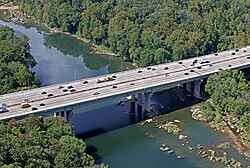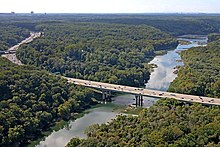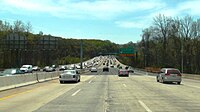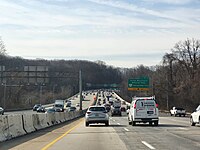American Legion Memorial Bridge (Potomac River)
American Legion Memorial Bridge | |
|---|---|
 | |
| Coordinates | 38°58′13″N 77°10′47″W / 38.97017°N 77.17962°W |
| Carries | 10 lanes of |
| Crosses | Potomac River |
| Locale | Montgomery County, Maryland and Fairfax County, Virginia |
| Official name | American Legion Memorial Bridge |
| Other name(s) | Legion Bridge |
| Maintained by | Maryland State Highway Administration |
| History | |
| Opened | December 31, 1962 |
| Statistics | |
| Daily traffic | 232,000 (2010)[1] |
| Location | |
 | |
The American Legion Memorial Bridge, also known as the American Legion Bridge and formerly as the Cabin John Bridge, is a bridge carrying Interstate 495 (Capital Beltway) across the Potomac River between Montgomery County, Maryland and Fairfax County, Virginia in the United States. It is an American Water Landmark. Plummers Island is located immediately downstream of the bridge.
The bridge has five traffic lanes in each direction. The outermost lane in each direction is an entrance/exit-only lane for traffic to/from the Clara Barton Parkway in Maryland and the George Washington Memorial Parkway and Georgetown Pike (State Route 193) in Virginia. There are no facilities for pedestrians or cyclists, which are prohibited.
History



Opened on December 31, 1962,[2] the bridge was originally named the "Cabin John Bridge" because of its proximity to the community of Cabin John on the Maryland side of the Potomac River. The bridge opened without a ceremony due to the cold weather.[3] On May 30, 1969, the bridge was officially renamed the "American Legion Memorial Bridge" in a ceremony led by Lt. Gen. Lewis B. Hershey, director of the U.S. Selective Service System.[4] This action reduced confusion with the Union Arch Bridge, which carries the Washington Aqueduct and MacArthur Boulevard across Cabin John Creek and which some people also called "the Cabin John Bridge". The bridge was widened from its original 6-lane configuration to the current 10-lane version by 1992 via a third span filling the median between what was originally two separate spans.[5]
The American Legion Memorial Bridge is an important commuter route because of its proximity to edge cities and high tech centers in Maryland and Virginia. It is the only high volume crossing between Montgomery County, Maryland and Fairfax County, Virginia, the most populous counties in their respective states. It is also the only major crossing between Maryland and Virginia between the Point of Rocks Bridge, more than 30 miles (50 km) upstream and the Chain Bridge downstream between the Commonwealth of Virginia and the District of Columbia. Congestion on the American Legion Bridge and commuter travel between the western Washington suburbs in both states has fueled support for a western bridge around the Loudoun County/Fairfax County line in Virginia (Virginia Route 28/Fairfax County Parkway area), or farther out as part of the Western Transportation Corridor.[6] Opponents claim that another bridge would increase development in those areas, increase traffic, and generate more pollution in the Chesapeake Bay.[7] The bridge crosses the western terminus of the Potomac Heritage Trail and the George Washington Memorial Parkway on the Virginian side of the Potomac River. On the Maryland side, the bridge crosses over MacArthur Boulevard, the Clara Barton Parkway and the Chesapeake and Ohio Canal. Lock 13 (Seven Locks 6) of the canal is underneath the bridge.
The American Legion Memorial Bridge is one of the two locations at which the Capital Beltway crosses the Potomac River; the other is the Woodrow Wilson Memorial Bridge.
American Legion Bridge expansion
In September 2017, Maryland Governor Larry Hogan announced plans to widen interstate highways I-270 and I-495 (Capital Beltway) with toll-funded express lanes planned, built, and operated through a public–private partnership (P3).[8] It was announced on November 12, 2019, that the existing spans will be rebuilt and replaced with a new structure expanding capacity from eight to twelve lanes.[9]
On July 10, 2020, the Maryland Department of Transportation (MDOT) released its more than 18,000-page Draft Environmental Impact Statement (DEIS) on the project, which addresses the construction project's impacts on people and the environment.[10]
The expansion project would destroy large parts of Plummers Island, which is located immediately downstream of the bridge. It would destroy or require relocation of the channel that separates the island from the mainland, clear-cut trees, and level a significant portion of the island. The native beech forest on the mainland side would also have to be cut down; wetlands between the mainland and the island would be destroyed, which can lead to a heavy infestation with invasive plants.[11]
In August 2022 the Federal Highway Administration approved the proposed project.[12] In October 2022 environmental and historic preservation groups filed suit against the state, citing deficiencies in the environmental review process and the projected impacts on Plummers Island.[13] In November 2022 MDOT announced that it would not award a contract for construction of the proposed expansion project until after Governor Hogan has left office in January 2023. Decisions on the project will be made by the administration of newly elected governor Wes Moore and the Maryland Board of Public Works.[14]
In August 2023, MDOT applied for a federal grant to support rebuilding of the bridge and expand a portion of I-495 leading to the junction with I-270.[15]
In December 2024, Northern Virginia leaders shared that the NOVA community needs to continue to apply pressure for the bridge project to be initiated.[16] Fairfax County Board of Supervisors Chairman Jeff McKay shared, "The bridge has to be rebuilt. It's way overdue. We're in a clock that is already ticking".[16]
See also
 Transport portal
Transport portal Engineering portal
Engineering portal Virginia portal
Virginia portal Maryland portal
Maryland portal- List of crossings of the Potomac River
References
- ^ Ronald F. Kirby, Director of Transportation Planning (July 25, 2012). "TRANSPORTATION ACROSS THE AMERICAN LEGION BRIDGE: The 50th Anniversary and Beyond - Current and Future Traffic" (PDF). Metropolitan Washington Council of Governments. Archived from the original (PDF) on February 2, 2017. Retrieved October 13, 2016.
- ^ "Cabin John Bridge Opens to Light Traffic". The Washington Post. January 1, 1963. p. B2. ProQuest 141929771.
- ^ "Cabin John Span Opens Monday: Cabin John Bridge To Open". The Washington Post. December 29, 1962. p. A1. ProQuest 141614157.
- ^ "Cabin John Bridge Given a New Name". City Life. The Washington Post and Times-Herald. May 31, 1969.
- ^ Northern Virginia Transportation Alliance. "American Legion Bridge". Retrieved October 12, 2016.
- ^ Ginsberg, Steven (May 11, 2004). "Traffic Study Renews 'Techway' Debate: Most Md. Drivers Who Cross Legion Bridge Turn West, Researchers Find". The Washington Post. Archived from the original on September 18, 2012. Retrieved September 18, 2012.
- ^ Chesapeake Bay Foundation (August 2001). "A Northern Potomac River Crossing: Will It Address Regional Congestion?" (PDF). Annapolis, Maryland: Chesapeake Bay Foundation. Archived from the original (PDF) on October 27, 2002. Retrieved October 27, 2002.
- ^ McCartney, Robert; Siddiqui, Faiz; Wiggins, Ovetta (September 21, 2017). "Maryland Gov. Larry Hogan proposes widening the Beltway and I-270 to include 4 toll lanes". The Washington Post.
- ^ Volou, Khalida; Franklin, Jonathan (November 12, 2019). "This new plan extend the American Legion Bridge from 8 to 12 lanes could impact your commute". WUSA9 TV News.
- ^ "MDOT Releases 19,000 Page Draft Environmental Impact Statement (DEIS): Local governments, grassroots organizations, and individuals tell MDOT the DEIS is flawed and the project has to stop". DontWiden270.org. November 15, 2020. Retrieved April 2, 2021.
- ^ "Plummers Island Threatened by proposed Expansion of American Legion Bridge". WBFC.science. Washington Biologists' Field Club. February 25, 2021. Retrieved April 2, 2021.
- ^ Duncan, Ian (August 26, 2022). "Controversial Hogan plan for Beltway, I-270 toll lanes gets green light". The Washington Post.
- ^ Uliano, Dick (October 11, 2022). "Environmental, historic preservation groups file suit to block Capital Beltway project". WTOP Radio News.
- ^ DePuyt, Bruce (November 17, 2022). "Decision on I-495/I-270 toll lanes contract delayed; project's fate now rests with Moore, new BPW". Maryland Matters.
- ^ Sears, Bryan P. (August 21, 2023). "State seeks federal grant to rebuild American Legion Bridge, I-495 toll lanes". Maryland Matters.
- ^ a b McCaffrey, Scott (December 12, 2024). "Local leaders want to maintain pressure on Maryland over American Legion Bridge". FFXnow. Retrieved December 12, 2024.
Further reading
- Laris, Michael (August 5, 2007). "Inspections Note Significant Flaws, But Officials Call Area Bridges Safe". The Washington Post. Archived from the original on May 2, 2014. Retrieved May 2, 2014.
- Tuss, Adam (January 30, 2012). "New Potomac river crossing coming?". WTOP Answer Desk. WTOP. Archived from the original on May 2, 2014. Retrieved May 2, 2014.
- Tuss, Adam (February 1, 2012). "Leaders talk seriously about new Potomac bridge". Local News. WTOP. Archived from the original on February 14, 2013. Retrieved February 14, 2013.
- Kunkle, Fredrick (March 30, 2012). "Maryland, Virginia revisit talks on possible new Potomac River crossing, officials say". The Washington Post. Archived from the original on May 2, 2014. Retrieved May 2, 2014.
- Samuel, Peter (December 4, 2012). "Virginia DOT study of Potomac River crossings, Maryland not interested for now". Toll Road News. Pine Street Publications, LLC. Archived from the original on May 2, 2014. Retrieved May 2, 2014.
- Di Caro, Martin (February 10, 2014). "McAuliffe Administration Reopens Possibility Of New Potomac River Bridge". WAMU. American University Bridge. Archived from the original on May 2, 2014. Retrieved May 2, 2014.
External links
- American Legion Memorial Bridge at Structurae
- Map and satellite image from Eyeball series


